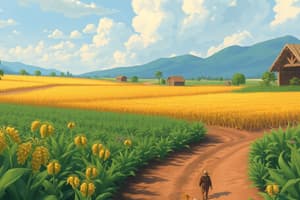Podcast
Questions and Answers
Which of the following is NOT an example of a legume crop?
Which of the following is NOT an example of a legume crop?
- Potatoes (correct)
- Soybeans
- Peanuts
- Beans
What is the purpose of ploughing in soil preparation for crop cultivation?
What is the purpose of ploughing in soil preparation for crop cultivation?
- To provide shade for the crops
- To control pests
- To increase soil fertility
- To loosen hard earth (correct)
Which of the following crops is classified as a tuber?
Which of the following crops is classified as a tuber?
- Berries
- Carrots
- Sweet potato (correct)
- Apples
Which category does jute belong to among the types of crops mentioned?
Which category does jute belong to among the types of crops mentioned?
In crop production, which planting method involves seeding crops in rows for proper growing conditions?
In crop production, which planting method involves seeding crops in rows for proper growing conditions?
What is the primary function of levelling the ground during soil preparation?
What is the primary function of levelling the ground during soil preparation?
What is the primary purpose of levelling fields in crop production?
What is the primary purpose of levelling fields in crop production?
Which irrigation method involves delivering small flows precisely where they are needed under trees or bushes?
Which irrigation method involves delivering small flows precisely where they are needed under trees or bushes?
What is the benefit of alternate wetting & drying (AWD) irrigation method?
What is the benefit of alternate wetting & drying (AWD) irrigation method?
How does fertilization contribute to crop growth?
How does fertilization contribute to crop growth?
Why is careful monitoring essential for both surface irrigation and subsurface drip systems?
Why is careful monitoring essential for both surface irrigation and subsurface drip systems?
In crop production, what does narrowing primarily help with?
In crop production, what does narrowing primarily help with?
Flashcards are hidden until you start studying
Study Notes
Crop Production and Management is an important aspect of agriculture, aiming to produce food and other products from plants grown in fields, farms, gardens, and greenhouses. This process involves several steps: selecting different crop varieties, preparing the soil, choosing the right planting method, nurturing them with water and nutrients, protecting them against pests, diseases, and weeds, harvesting the matured crops, and finally storing or using these crops. Let's explore each step further.
Types of Crops
Crops can be classified into various categories based on their usage. Some common examples include cereals such as wheat, corn, rice; legumes like soybeans, peanuts, beans; vegetables such as potatoes, peas, carrots; fruits including citrus species, berries, bananas, apples; oilseeds comprising cottonseed, sunflower seeds, palm kernels; tubers like cassava, sweet potato, yams; nuts like almonds, walnuts, pecans; and fibre crops such as jute, hemp, flax. Each type requires specific cultivating techniques and care. For example, some crops grow better when planted directly during fallow periods while others need to be seeded in rows for proper growing conditions.
Soil Preparation
Before sowing any kind of crop, farmers must prepare the ground properly by ploughing, narrowing, draining, levelling, and fertilizing it. Ploughing helps loosen hard earth, making it easier for roots to penetrate deeper while providing more space for air circulation and moisture absorption. Narrowing breaks up clods and removes stones and rocks which may otherwise harm the tender young shoots. Drainage ditches prevent waterlogging and enable excess rainwater to flow out easily without damaging newly sprouted baby plants. Levelling ensures that every part of the field receives equal amounts of sunlight throughout the day, leading to uniform growth among all crops. Fertilization provides essential minerals necessary for strong healthy growth.
Irrigation Methods
There are two primary ways to supply water to crops: surface irrigation (flooding) and subsurface drip irrigation systems. Surface irrigation ensures an even distribution across large areas, while subsurface drip systems deliver small flows precisely where they are most needed under trees or bushes. Both require careful monitoring since too much or too little water could lead to poor yields or dead plants respectively. Additionally, alternate wetting & drying (AWD), also known as intermittent saturated zone technique or cyclical irrigations, has been shown to reduce disease pressure and increase productivity. In this system, fields are flooded only once per cycle instead of continuously, allowing time for the lower layers to dry out before being rewetted again later.
In summary, crop production and management involve selecting suitable crops, preparing the land adequately, deciding on appropriate irrigation strategies, protecting plants from threats, and finally harvesting the matured crops efficiently. By combining knowledge of types of crops, soil preparation techniques, and irrigation methods, farmers can ensure productive harvests year after year.
Studying That Suits You
Use AI to generate personalized quizzes and flashcards to suit your learning preferences.



